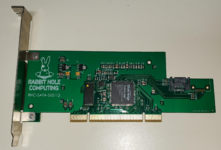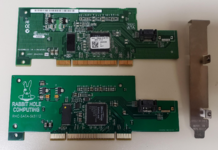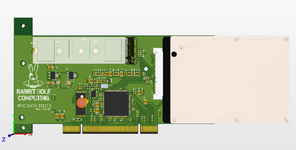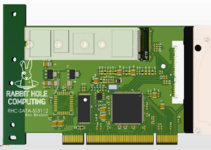rabbitholecomputing
Vendor The First
It's hard to believe SATA is 20 years old, but on January 7th, 2003, the SerialATA working group published the Serial ATA 1.0a specification, and the computing world finally had a low-cost serialized storage interface for the masses. By the end of the same year, Adaptec had released their SATAConnect The ubiquitous Silicon Image SiI3112A chipset, as used in many, many PCI storage cards, is just as old,
TL;DR We cloned a high-quality SATA PCI card, and are making a SATA 1.0 hard card out of it. See below for photos of how that is playing out.
We chose the Adaptec ASH-1205SA (The AAR-1210SA RAID uses the same board design, the only difference is firmware), which was based on the SiI3112A SATA controller IC. It's a four layer board, with internal ground and power planes. All components are surface-mount.
Since it won't be possible for us to ship these boards with firmware, eventual users will need to flash their own Macintosh-compatible firmware to the board, via flashrom. There's not yet any firm timeline for when these will be available for purchase, and it's unlikely it will be available before March. The prototype PCBs do not have beveled card-edges, as production units would.
Here's the first 1:1 assembled and tested clone:

Here's an original Adaptec ASH-1205/1210SA (same PCB) that we cloned, next to the resulting clone board. Some of the capacitors from the Adaptec board were cannibalized to test the initial prototype. The majority of the passive components, as well as the voltage regulators on the PCB, were assembled via pick-and-place. Once we received the partially-assembled prototypes, we then hand-mounted the SiI3112, harvested from a low-quality Chinese donor board via hot air rework. A small quantity of the flash memory was purchased off eBay, and soldered down.

Now that we've validated that the 1:1 clone works well, here's where we're evolving this design to be. It has one M.2 SATA connector, and one power+SATA connector for a 2.5" SATA SSD, with two mounting holes in the PCB to securely fasten the 2.5" drive from the bottom.

TL;DR We cloned a high-quality SATA PCI card, and are making a SATA 1.0 hard card out of it. See below for photos of how that is playing out.
We chose the Adaptec ASH-1205SA (The AAR-1210SA RAID uses the same board design, the only difference is firmware), which was based on the SiI3112A SATA controller IC. It's a four layer board, with internal ground and power planes. All components are surface-mount.
Since it won't be possible for us to ship these boards with firmware, eventual users will need to flash their own Macintosh-compatible firmware to the board, via flashrom. There's not yet any firm timeline for when these will be available for purchase, and it's unlikely it will be available before March. The prototype PCBs do not have beveled card-edges, as production units would.
Here's the first 1:1 assembled and tested clone:

Here's an original Adaptec ASH-1205/1210SA (same PCB) that we cloned, next to the resulting clone board. Some of the capacitors from the Adaptec board were cannibalized to test the initial prototype. The majority of the passive components, as well as the voltage regulators on the PCB, were assembled via pick-and-place. Once we received the partially-assembled prototypes, we then hand-mounted the SiI3112, harvested from a low-quality Chinese donor board via hot air rework. A small quantity of the flash memory was purchased off eBay, and soldered down.

Now that we've validated that the 1:1 clone works well, here's where we're evolving this design to be. It has one M.2 SATA connector, and one power+SATA connector for a 2.5" SATA SSD, with two mounting holes in the PCB to securely fasten the 2.5" drive from the bottom.




